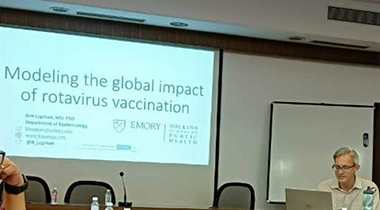
Events
NDMC hosted invited talks by Prof. Ben Lopman, Emory University, Atlanta, USA on Modelling the global impact of rotavirus vaccination and Comprehensively profiling social contact patterns in resource poor settings: The GlobalMix Project and by Prof. Venkata Raghava Mohan, Christian Medical College, Vellore, Tamil Nadu on Early impact of monovalent Rotavac vaccine on rotavirus disease in India.
April 24, 2023
Ben Lopman, PhD, is Professor of Epidemiology and Environmental Health at the Emory University Rollins School of Public Health. Prior to joining the RSPH faculty in 2016, he worked at the CDC as an epidemiologist with the Division of Viral Diseases. Dr. Lopman has authored over 300 peer-reviewed publications. He is Principal Investigator of multiple NIH, CDC, WHO and Bill and Melinda Gates Foundation grants and serves as a consultant to the World Health Organization. He is an elected Fellow of the Association for the Advancement of Science (AAAS).

Dr. Venkata Raghava Mohan is Professor and Chair of the Department of Community Health at Christian Medical College, Vellore. Having finished his Masters degree in Community Medicine at CMC, Vellore he has acquired training in Environmental and Spatial epidemiology during his MPH at Tufts University, USA. His areas of interest include Health Information Systems, Spatial and Environmental epidemiology with focus on enteric infections, antimicrobial resistance, child malnutrition, vaccine impact assessment and water sanitation and hygiene. Currently, Dr Mohan is an investigator on many large scale multi-centric studies looking at rotavirus vaccine impact assessment in India, burden of enteric fever in India, environmental surveillance for polio viruses, salmonella and antimicrobial resistance genes in Vellore. He has mentored over 25 post graduate students and has close to 150 publications in indexed national and international journals.

Summary
1. Modeling the global impact of rotavirus vaccination
Rotavirus remains the leading etiology responsible for under-5 deaths from enteric
infections globally, resulting in over 151,000 deaths in 2019. Rotavirus vaccine has
been introduced in over 100 countries globally. Vaccine efficacy varies across
countries based on disease burden and demographics raising questions on variable
vaccine impact. Over many years and for multiple studies, Dr. Lopman and his group
have developed a mechanistic model of rotavirus epidemiology and transmission. To
assess global vaccine impact, country-specific factors such as vaccine efficacy,
transmission intensity, and demography were incorporated into the model to estimate
the overall impact of rotavirus vaccination. This work was part of the Vaccine
Impact Modeling Consortium (VIMC) funded by Gavi.
In his talk, Dr. Lopman described the model and how it leads us to conclude that rotavirus vaccination can avert a substantial amount of child mortality across low-and-middle-income countries. Most of these benefits are due to direct effects of vaccination. While the absolute numbers of deaths prevented is highest in lower income settings, larger indirect (i.e. herd immunity) effects were found in European countries. A wide range of programmatic and biological factors may affect the impact of rotavirus vaccination. These factors will be considered in light of the introduction of vaccines in India.
2. Early impact of monovalent Rotavac vaccine on rotavirus disease in India
Rotavirus causes an estimated 11.37 million episodes of acute gastroenteritis in
children <5 years of age. India accounts for 22% of the total global mortality
from rotavirus infection. According to the Global Burden of Disease Study,
approximately 21,375 deaths have been estimated from rotavirus infection in
children <5 years of age. In India, the National Rotavirus Surveillance Network
is an ICMR initiative that started in 2005 at 3 hospital sites and eventually
expanded to 28 sites by 2016 in three phases. Between 2012 and 2016, a total of
21,421 children were enrolled, of which 36.3% were positive for rotavirus. The
most common genotypes were G1P[8] (52.9%), G9P4 (8.7%) and G2P4 (8.4%). The
National Immunisation programme included 2 vaccines: the monovalent Rotavac and
the pentavalent Rotasiil vaccines. Results from clinical trials reported
efficacies of 53.6% and 36%-66.7% for Rotavac and Rotasiil, respectively,
against severe rotavirus diarrhea in children <1 year of age from low- and
middle-income countries.
In this talk, Dr Mohan discussed the effectiveness studies on Rotavac and Rotasiil in the states where these vaccines were introduced as part of the Universal Immunisation Programme. Rotavax was introduced in 2018 in 9 states, whereas Rotasiil was introduced in 2019 in 5 states. The effectiveness of these vaccines against all severities of rotavirus infection, the common strains observed during the study, and the effectiveness of the vaccines against these strains were discussed. Overall, the data showed a significant reduction in rotavirus induced gastroenteritis during the post vaccination period among children who were enrolled in the study.
3. Comprehensively profiling social contact patterns in resource poor settings:The
GlobalMix Project
Social mixing data are the cornerstone of understanding the transmission and
modelling the control of pathogens that spread via close contact. However, there is
a
lack of data on social contact patterns particularly from low-and-middle-income
countries. Comparability is hampered with different study protocols, definition of a
contact and data collection procedures and many modellers rely on European contact
data projected onto low-and-middle-income country populations.
To address this gap, Dr. Lopman and his group are quantifying social contact patterns in 8 rural and urban sites of Mozambique, Guatemala, India, and Pakistan through TheGlobalMix Study. For each country, 1,260 participants report, in a paper diary, individuals with whom they had contact over two days, and characteristics of those contacts. In addition, members of 126 households carried wearable proximity sensors over 7 continuous days and concurrently kept a diary of all contacts over two of those days. Each sensor autonomously detects dyadic face-to-face (<6 feet separation) interactions between household members. The contact rates and matrices stratified by standardized definitions of age, sex, relationship, occupation, location, and duration of contacts for each site and country will be presented.
Since 2021, Dr. Lopman and his group have collected data in Mozambique, Guatemala, and India. Data collection is ongoing in Pakistan. Dr. Lopman presented preliminary data from completed sites and showcased the utility of their data. An overarching value of The GlobalMix Study is to make the tools, methods, and data available to the scientific community for use in mathematical models of infectious disease transmission and control.
